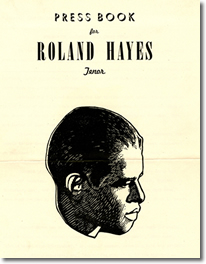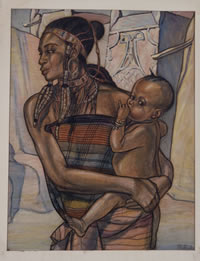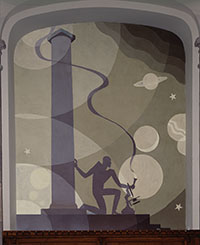Separation and Exclusion: Fisk University and the Arts
by Reavis L. Mitchell, Jr., Professor of History and Dean of the School of Humanities and Social Sciences, Fisk University

In an era of separation and exclusion, Fisk University holds a unique position as a purveyor of the cultural arts. Opened in 1866 in Nashville, Tennessee, after the Civil War and during Reconstruction, Fisk would develop a preeminent position in the art and culture of the United States. When the United States Congress failed to reauthorize the Freedmen’s Bureau in 1872, Fisk, just as other institutions organized and funded for the formerly enslaved African Americans, would lose much of its support and funding. In an act of desperation, a student chorus was organized to raise funds for the struggling institution. This group would become known as the Fisk Jubilee Singers. From the earliest days of Fisk, originally the Fisk Free Colored School, students of all ages had shown an interest in music. As the school grew into a university, student interest in vocal performance remained undiminished. Fisk Treasurer, George White, who had heard the students sing a capella, developed a special appreciation for what he heard and began to form the students into small choral groups as early as 1867. He also began proposing tours of student singing groups as fund-raisers to meet some of the school’s immediate needs. At first, however, White’s idea of having students sing to raise funds met almost total opposition.
Early in the spring of 1871, University Treasurer White contacted Erastus Milo Cravath, Field Secretary of the American Missionary Association, concerning a northern tour by Fisk University students. The purpose of the tour would be to raise funds by presenting musical performances. In this era of separation and exclusion, White was confident that northern white audiences had never seen African American students give performances of the caliber presented by the Fisk University students. White pointed out that, in May of that year, Fisk Students had performed in a successful concert in Gallatin, Tennessee. They had presented a refined image with their deportment. Yet, the American Missionary Association officials stated that they saw no advantage of a northern tour.
In what must have been seen as a monumental decision at the time, the local Fisk University trustees decided to undertake the northern tour without the support of the American Missionary Association. Students were selected and prepared in the summer of 1871 for a tour to take place during the 1871-1872 school year. Even after the difference of opinion between the local university trustees and the American Missionary Association, George White continued to ask the association’s assistance. Although Cravath was finally convinced that the proposed tour could be successful, he declined to finance the tour or accept financial liability. Undaunted, White continued to seek funding for the tour and approached the former Assistant Commissioner for the Tennessee Freedmen’s Bureau, General Clinton B. Fisk, who was the university’s namesake. Even General Fisk refused the request, fearing that the tour would fail and that the school’s reputation would suffer.
In the autumn of 1871, Fisk University students performed to segregated audiences during an eight-day tour of southern Tennessee and northern Georgia. Afterward, their expenses were paid. They had raised $47.95; that was enough encouragement to pursue a tour in the north. On October 6th, 1871 the planned northern tour began. Nine students financed by borrowed money and all except $1 of Fisk University’s funds embarked upon their mission to save the school. George White accompanied these African Americans on what would become one of the most significant and poignant events of not only African American history but American history.
Fisk’s students made their way to Cincinnati, Ohio, to begin their northern tour. Next, they traveled northeast to Chillicothe, Ohio, for their second performance. The two concerts made a small profit of $50. That autumn, however, was one of the most eventful in America’s post-Civil War era. A major disaster ignited the night of October 8, 1871. The Chicago Fire, the inner-city inferno, raged for twenty-nine hours. It took three hundred lives and injured hundreds more, leaving 90,000 homeless in refugee camps. Responding to this disaster, the sympathetic Fisk Students donated their funds to the Chicago Fire Relief Drive. This selfless act of charity easily could have ended their tour and snuffed out the flames of hope for Fisk’s future, had not their benevolence been rewarded. The singers were invited to perform before a meeting of the National Council of Congregational Churches in Oberlin, Ohio. The concert was pivotal in two ways: a collection of $130 was presented to the singers, and those assembled at the Oberlin meeting sent an endorsement of the group to the American Missionary Association.
During their first northern tour, the Fisk Singers performed Negro spirituals as an encore following their concert of “mainstream” sacred songs. As a result of an enthusiastic response to the Singers' spirituals, or slave songs as they were often called, a greater portion of each performance began to be devoted to the spirituals. It was from the performance of these spirituals that the Fisk Singers derived their name. George White, after a long night of prayer and thanksgiving for the auspicious beginning of the tour, remembered the Biblical reference (Leviticus 25: 8-17) to the “Year of Jubilee” when the Hebrew slaves were set free amid rejoicing and jubilation.
The northern tour continued, with some successes and many indignities. The singers were often refused accommodations in white-owned hotels because they were African Americans. In New York City, they were forced to stay in private homes. Yet, they persevered and traveled through the eastern states and to New England. During a most memorable week in Connecticut, the Jubilee Singers received $4000 in contributions (eventually, they would earn that amount for just one concert in Boston, Massachusetts). In Washington, D.C., the singers performed for President Ulysses S. Grant, Vice President Schuyler Colfax, and Tennessee Senator William G. Brownlow. The first tour concluded with a performance in Poughkeepsie, New York. White and the singers returned to Nashville on May 2nd, 1872. After only one week’s rest, the troupe resumed its tour and traveled to Boston to participate in the second World Peace Jubilee. The great Austrian conductor and composer Johann Strauss, the younger, heard their performance and reportedly waved his violin in the air to demonstrate his approval and jubilation.
Towards the end of 1872, the troupe formulated plans for a European tour. Excitement mounted. Mark Twain, the noted American author and an admirer of the Jubilee Singers, reportedly began to sing spirituals for his family and friends; he also wrote to friends in England expressing support for the Jubilee Singers. In early 1873, the Jubilee Singers and George White boarded a ship for England. The Jubilee Singers gave a stirring performance for members of Parliament and English nobility on May 6th, 1873, at the invitation of Lord Anthony Ashley Cooper, the seventh Earl of Shaftesbury, a member of the House of Commons and an English social reformer. The singers soon gave another soulful performance for the Duke and Duchess of Argyle at which Queen Victoria was present. Prime Minister William E. Gladstone invited the singers to perform at his residence on three occasions. The Jubilee Singers gave concerts for missionary societies, churches, and temperance organizations, and then continued the tour through Scotland, Ireland, and Wales.

In a monumental expression of her appreciation, Queen Victoria instructed the royal court portrait painter, Edmund Havell, to create a portrait of the singers. This magnificent floor-to-ceiling portrait, which hangs today in Fisk University’s Jubilee Hall, built with funds raised by their performances, beautifully captures the wide range of skin hues of African Americans and presents the handsome troupe as perfect young Victorians. The portrait is dazzling, and the gift of royal portraiture founded a great collection of art to benefit student educational growth at Fisk. Thus began a tradition of art collecting as a part of the culture of Fisk University. The contributions of the original Fisk University Jubilee Singers, as well as those who joined the group during this seven-year period, are immeasurable. Not only was the spiritual established as an authentic musical expression worthy of respect, but a new image of African Americans was also created in this era of separation and exclusion. Somewhat formal in appearance and highly trained in classical music, the Jubilee Singers refuted the negative image of the African American as undisciplined.
A Jubilee Quartet, organized under the direction of Professor John W. Work, Jr., began recording and touring in the early 1910s. During this period, those acclaimed as the best student performance groups in the country were the Harvard University Glee Club, The Saint Olaf College Chorus, and the Fisk University Jubilee Quartet.
Until the 1930s, Fisk had been widely recognized more for its musical contributions than its artistic contributions. The highly respected Fisk Jubilee Singers had become dominant in the area of spiritual music and gained international fame. Members of the Mozart Society, organized in 1880 by Fisk’s first dean, Adam K. Spence, studied and performed classical music. John W. Work, Jr., a Fisk alumnus who served as professor of Latin and directed the Jubilee Quartet, introduced folk music as a subject worthy of study at Fisk University by collecting and writing folk arrangements and publishing The Folk Songs of the American Negro in 1915.
His son, John W. Work, III, won international recognition as a composer, author, and collector of spirituals and folk music. He, too, became a member of the Fisk faculty. His American Negro Songs and Spirituals was published in 1940, and he won first prize in a 1946 competition of the Fellowship of American Composers for his composition “The Singers.”
During the 1930s, Fisk extended its musical fame through a weekly radio broadcast. The Columbia Broadcasting System (CBS) was so impressed with the positive response to the program that the University was invited to broadcast a one-hour musical presentation entitled “Hello Europe.”

In 1931, Chicago businessman Samuel Insull presented a collection of 300 pencil sketches and watercolor paintings by Cyrus LeRoy Baldridge to Fisk University. Charles S. Johnson, former Director of Research for the Urban League and Professor of Sociology at Fisk, stated: “The Baldridge Collection represents the best representation available of African Life.” The New York Times, in reporting on the donation of the art collection stated that “Fisk University [is] becoming a cultural center” and that Fisk University was becoming “a virtual art center in the South.”
This was all taking place in the era of separation and exclusion. In 1937, there was great excitement when prominent Harlem Renaissance artist Aaron Douglas, a sought-after muralist, was invited to join the faculty at Fisk and to organize a faculty around an academic study of art and painting as an academic curriculum. As an illustrator for both the NAACP’s The Crisis and the Urban League’s Opportunity magazines during the 1920s and 1930s, Douglas had won acclaim as an exponent of the “African Impulse” in American Art. As a participant in the cultural phenomena known as the Harlem Renaissance, Aaron Douglas had made visible African American identity. Douglas’ murals in his angular style depicting the emergence of an African to an African American had graced the walls of Fisk University’s new Erastus Milo Cravath Memorial Library since 1930. His works also adorned the walls of Harlem’s Young Men’s Christian Association building, as well as the walls of the 135th Street Countee Cullen Library, a part of the New York Public Library system. Douglas had been invited to create murals at Bennett College in Greensboro, North Carolina in 1931. For twenty-nine years, Aaron Douglas served Fisk University, both as teacher and artist. In an era of separation and exclusion, Douglas demonstrated his appreciation of his African heritage at the same time that creative writers and playwrights did so through literature and the dramatic experience.

In the case of music—just as in the case of art—Fisk’s enhanced reputation led to donations of new collections. “The George Gershwin Memorial Collection of Music and Music Literature,” a collection of books, music, photographs, published music, phonograph records, manuscripts, letters, and scrapbooks, was donated by music critic, author, and photographer Carl Van Vechten in 1943. It came as a great surprise to many in the artistic community when Georgia O’Keeffe, one of America’s foremost artists and the widow of pioneering artistic photographer Alfred Stieglitz, presented the Alfred Stieglitz Collection of Modern Art to Fisk University. The Stieglitz Collection contains more than one hundred original paintings, watercolors, lithographs, etchings, and sculptures by a variety of artists, and photographs on chloride by Alfred Stieglitz. Besides Stieglitz, artists represented in the collection include American Modernists O’Keeffe, Charles Demuth, Arthur Dove, Marsden Hartley, John Marin, and Charles Sheeler, among others, as well as Mexican artist Diego Rivera and Europeans Paul Cezanne, Pablo Picasso, Pierre-Auguste Renoir, Gino Severini, Paul Signac, and Henri de Toulouse-Lautrec. Fisk University President Charles S. Johnson presided over the formal public opening of the Stieglitz Collection of Art in November 1949. This event drew international attention to Fisk University as a center of great artistic collections.
The Stieglitz Collection was housed in the newly remodeled Carl Van Vechten Gallery, transformed at O’Keeffe’s direction into a museum worthy of a premier art collection. The historic structure, which was originally constructed in 1883 as an Episcopal Church to serve the campus community, had earlier been converted into a gymnasium for physical education at the behest of Dr. William Edward Burghardt (W.E.B) Du Bois and his Fisk graduating class of 1888. The development of a gymnasium for calisthenics was a part of Du Bois’ vision that African American students should be educated to become part of the “Talented Tenth” of American society.
Fisk’s art collection grew further when Irene McCoy Gaines presented a collection of African art to the University in 1952. Mrs. Gaines’ gift was made in memory of her uncle, George W. Ellis, who served from 1902 to 1910 as Secretary to the American Legation in Monrovia, Liberia. The collection, containing two hundred and fifty-two pieces of African art, is a portion of the George W. Ellis African collection formerly held by the Smithsonian Institution. Ellis, who was appointed to his post by President Theodore Roosevelt, was a recognized authority on West African culture and African art. The same year, Carl Van Vechten presented the Florine Stettheimer Memorial collection of books on fine arts to Fisk University. The Stettheimer collection contains more than twelve hundred volumes.
In an era of separation and exclusion, the arts—musical, artistic, and literary—and the donation of prestigious collections such as these, brought much attention to Fisk University, opening doors that otherwise might have remained solidly closed. The value of the arts to a widening of the human spirit can never be overemphasized.
Suggested Citation
Mitchell, Reavis L. "Separation and Exclusion: Fisk University and the Arts." Trials and Triumphs: Tennesseans' Search for Citizenship, Community, and Opportunity. Middle Tennessee State University, 2014. Web.